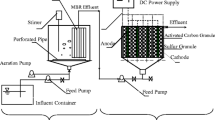Abstract
Denitrification of a high-strength synthetic wastewater (150 g NO- 3 l-1) was carried out using a wine distillery effluent as an example of an industrial carbon source (22.7 g chemical oxygen demand l-1). Two configurations were tested: one consisted of an acidogenesis reactor followed by a denitrifying reactor and the other was a single reactor directly fed with the raw effluents. In both cases, denitrification was achieved at a nitrate load of 9.54 g NO- 3 l-1 day-1 (2.19 g N as NO- 3 l-1 day-1) with good specific reduction rates: 32.6 mg and 35.2 mg N as NO x g volatile suspended solids h-1, calculated on a single day, for the two-step and the one-step process respectively. Dissimilatory nitrate reduction to ammonium did not occur, even in the one-step process.
Similar content being viewed by others
Author information
Authors and Affiliations
Additional information
Received: 26 October 1995/Received revision: 15 February 1996/Accepted: 20 February 1996
Rights and permissions
About this article
Cite this article
Bernet, N., Habouzit, F. & Moletta, R. Use of an industrial effluent as a carbon source for denitrification of a high-strength wastewater. Appl Microbiol Biotechnol 46, 92–97 (1996). https://doi.org/10.1007/s002530050788
Issue Date:
DOI: https://doi.org/10.1007/s002530050788




